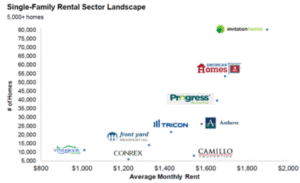In March of 2012 Warren Buffet said, and I paraphrase, “… If I had a way of managing a couple hundred thousand single family homes, I would load up on them… it’s probably as attractive an investment as you can make.” Link to video here.
It’s not surprising the most renowned investor in history would say this since single family rentals, when purchased correctly, provide 5 powerful benefits:
1. Cash Flow
2. Appreciation
3. Mortgage Principal Paydown
4. Tax Benefits Including Tax Sheltered Income
5. Inflation Profiting
Well, large companies have now figured out how to manage single family rentals at scale and have loaded up on them. The housing market may never be the same.
Historically, the predominant force driving the single family home market has been owner occupants. While owner occupants remain a significant segment, the universe of competing entities has rapidly grown.
There is currently strong demand for single family homes from:
1. Owner Occupants
2. Domestic Mom and Pop Landlords (You and me)
3. Foreign Mom and Pop Landlords (People from all over the world)
4. Mega Portfolio Operators (Invitation Homes, America Home For Rent etc…)
5. Domestic Institutional Funds (Fundrise etc..)
6. International Institutional Funds (Allianz SE, Pension Investment Board of Canada etc.)
7. Start-up Companies (Arrived Homes – backed by Jeff Bezos, etc..)
8. Family Offices
9. I-Buyers (Open Door, Offerpad, Sundae etc…)
10. Airbnb Hosts
Below is a visual of the number of homes owned by just the largest portfolio operators in the country. These companies are cash rich, hungry for more homes and in hyper-acquisition mode. 
With all of this demand, in a supply constrained environment, is it surprising that home values are up 21 percent over the last 2 years? (As per the Case-Shiller National Home Price Index)
So What’s Next?
With technology now available to support portfolio management at scale and so many players in the game, what will reverse the trend? Here are some things to consider:
Supply – There is a lot of motivation in the market to build new inventory and many companies are working furiously to acquire land and build. This process takes time and the market may not feel the benefits of new supply for years.
Demographic Shifts – The cohort of people now coming into prime home buying age (Millennials or Gen Y) is the largest in history. This is shaping demand in a big way. The cohort behind them (Gen Z) is smaller and therefore it’s logical that not as many homes will be needed over time. The effects from this however, won’t be felt for many years.
Technological Innovation – Throughout history problems have mothered innovation. In an environment where a housing shortage continues to worsen, innovation is more likely. Perhaps things like 3D printed homes, offsite modular construction or other technological advances at scale can reduce the cost of creating homes or significantly increase the speed of production.
A New & Better Asset Class Emerges – Money flows to where it earns the best risk adjusted returns. Institutional money would quickly migrate out of SFR’s if the projected returns were higher in a different investment vehicle. This will most likely happen eventually, but not in the foreseeable future.
What Does It Mean For You and Me?
As a buy and hold investors trying to compete, here are some things that I am focused on:
Provide a great experience for renters – Buy and hold investors earn their greatest returns when there is minimal turnover in their rentals. Give tenants an awesome experience and they are more likely to want to stay in your home. Over time, having a reputation of providing a clean, safe and affordable property where maintenance requests are quickly handled will attract longer term tenants.
Go to smaller markets to get ahead of the curve – By nature, institutional investors need to operate at scale and therefore, they target larger markets where they can find bulk deals. By going to smaller markets, there will be less competition from them (at least for now). Over time, as institutions continue to compete with each other, it would not surprise me if they try to scale across smaller markets.
Target 4 unit townhome buildings – While not exactly the same as SFR’s, 4 unit townhome buildings, in many ways, behave similarly. The most compelling reason to target 4 units is that you can still get the same, powerful 30 year fixed rate mortgages on them. Buffet mentions some of the great benefits of these mortgages in the video referenced above. With 4 units, you get higher gross rents per building. As an investor, you won’t be competing with SFR owner occupants when you target 4 unit buildings.
Summary
A vast array of individuals, companies and institutions have now figured out that a single family home in the United States is one of the best financial investment vehicles on the planet.
Values continue to rise as competition persists. While we won’t continue to see the same rates of appreciation that we have seen over the last 2 years, in my opinion, barring any unprecedented geopolitical disruption or other black swan event, it will take years for there to be a significant reversal of the general positive trend.
To remain competitive, buy and hold sfr investors can focus on providing a better tenant experience, target areas where institutions don’t play and expand into 2-4 unit townhome buildings.












